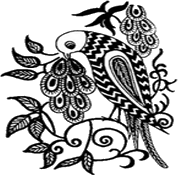Finesse in flowers-petal designs, curves and delicacy are the prime specialties of Sanganer prints. The curvature of flowers in the ’bootas’ is generally shown on the right side. Different types of flowers and plants are displayed in the form of ‘bel’ (a border) and ‘boota’ very naturally and in a really attractive manner.
Some of the flowers used in the prints are roses, rosettes, lotuses, lotus bud, sunflower, lily, ‘champa’ ‘canna’ ‘nergis’, marigold etc. Various other flower creations are also found in old Sanganeri prints. Other flowers used are locally known as ‘sosan’, ‘gainda’, ‘gulmehendi’, ‘javakusum’, ‘guldaudi’, ‘kachnar’, ‘jatadari lily’, ‘kaner’, ‘kanna’, ‘gullalla’, etc. ‘Sosan’ and ‘gullala’ prints are probably very suitable to sanganeri prints, therefore they are used in various forms.
In ‘booties’, generally, only one type of flower-petal and bud creations in the following forms : ‘badam, (almond)’, ‘paan’ (beetle leaf), ‘mukut of ‘kalanga’, While printing a saree, if the ‘booti’ is of ‘sosan’ flower or plant the ‘bel’ will also be of ‘sosan’ flower and the big’boota’ to be done on the ‘pallu’ (the end part of a saree) will also be of ‘sosan’ flower decoration. Hence, for printing one sari, a large number of blocks need to be made. In some ‘booties’ one finds a collection of more than one flower in the same product. Sometimes two different blocks of two different ‘booties’ are printed together to form a third type of ‘booti’ e.g. ‘Singhbal booti’. By printing different booties together, the Sanganeri ‘chhipas’ have portrayed excellent know how. Sometimes more than three flowers are fitted beautifully in a single ‘booti’ e.g. in ‘Latkan booti’ banana tree, sosan tree and saro tree collection in assembled beautifully in one pattern.Different ‘boota’ booti, and ‘bel’ have been named by the ‘chhipas’ according to their shape find according to the flowers and fruits used in those. These were very appropriate and interesting.
Many flowers used in Sanganeri prints are not found in Rajasthan, and most of the craftsmen of Rajasthan have never seen them. On this basis, Historian James watt has said, “Obviously many of the Sanganeri designs portray flowers that in not likely to have been seen by the calico printers nor by the block engravers of Rajputana. In spite of these circumstances, however, there seems every reason to believe that the craft has been handed down for centuries and has come to use in all the purity of original inspiration. The nature, feeling and color reciprocity, as also the technique in printing are all perfect while the absence of machine regularity gives a charm that place these goods above and beyond anything as yet accomplished in Europe.” Apartfrom flowers, fruit trees of banana, dates, grapes pomegranate etc. have also been recreated in a very attractive manner. In some old prints figures of parrots and fish are also seen. Since about fifty years, elephant. Horse, camel, peacock and human figures are also used. These are mostly seen on curtains, bed-covers, table clothes etc.The doo-rookhi style of printing is also popular in Sanganer. This is printing done on both sides of the fabric.
|



